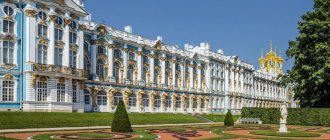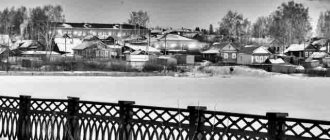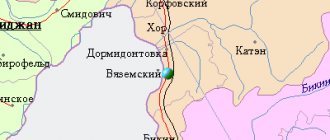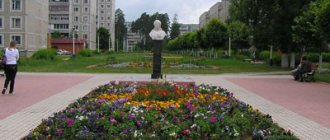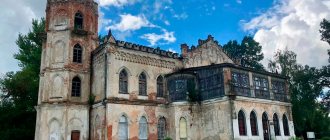Zhukovka
(Bryansk region)
OKATO code:
15222501
Founded:
1868
Urban settlement since:
1931
City since:
1962 City of district subordination (Zhukovsky district, Bryansk region)
Center:
Zhukovsky district
Telephone code (reference phone)
| 48334***** | — |
Deviation from Moscow time, hours:
0
Geographic latitude:
53°32′
Geographic longitude:
33°44′
Altitude above sea level, meters:
170 Sunrise and sunset times in the city of Zhukovka
Zhukovka (Bryansk region)
Zhukovka:| Rzhanitsa | 16 (19) | SE | |
| 2 | Dubrovka | 23 (43) | NW |
| 3 | Old | 29 (72) | IN |
| 4 | Seltso | 30 (45) | SE |
| 5 | Rognedino | 32 (57) | WITH |
| 6 | And so | 34 (48) | NE |
| 7 | Sescha | 34 (50) | NW |
| 8 | Zhiryatino | 34 (69) | IN |
| 9 | Kletnya | 37 (51) | SW |
| 10 | Dyatkovo | 40 (60) | IN |
| 11 | Lyubohna | 43 (70) | IN |
| 12 | Fokino | 46 (87) | IN |
| 13 | Suponevo | 52 () | SE |
| 14 | Bryansk | 52 (65) | SE |
| 15 | Vygonichi | 53 (90) | SE |
| 16 | Betlitsa (Kaluga region) | 55 (159) | WITH |
| 17 | Lyudinovo | 59 (94) | NE |
| 18 | Bolshoye Polpino | 60 () | SE |
| 19 | Ershichi (Smolensk region) | 66 (127) | Z |
| 20 | Pochep | 69 (144) | YU |
| 21 | Zhizdra | 70 (120) | IN |
| 22 | Kirov | 71 (124) | NE |
| 23 | White Shores | 71 (93) | SE |
| 24 | Desnogorsk | 74 (108) | NW |
| 25 | Roslavl | 74 (91) | NW |
| 26 | Mglin | 79 (112) | SW |
| 27 | Khvastovichi (Kaluga region) | 90 (290) | IN |
| 28 | Shumyachi (Smolensk region) | 93 (127) | NW |
| 29 | Navlya | 93 (128) | SE |
| 30 | Karachev | 95 (112) | SE |
a brief description of
The city is located on the left bank of the river. Desna (Dnieper basin), 56 km northwest of Bryansk.
Navigation (irregular) along the Desna begins from Zhukovka. Railway station.
Territory (sq. km): 13
Historical sketch
It was founded as a village in 1868 in connection with the construction of the Orel – Riga railway.
Until 1918, a small iron foundry, S.S., operated in Zhukovka. Radushevich.
Since October 30, 1931, the working settlement of Zhukovka.
During the Great Patriotic War of 1941-45 it was occupied by Nazi troops from September 1941 to September 1943.
City since 1962.
Economy
Leading enterprises: “Zhukovsky Bicycle Plant” (Desna bicycles), “Zhukovsky Experimental Plant”, “Furniture Factory”.
In the Zhukovsky district, grain crops, potatoes, and vegetables are grown. They raise cattle, pigs, and poultry.
Main enterprises
PRODUCTION OF MOTORCYCLES AND BICYCLES
JSC “Zhukovsky Bicycle Plant”
242800, Bryansk region, Zhukovsky district, Zhukovka, st.
Kalinina, 1 Offers:
bicycles
Culture, science, education
35 km from Zhukovka, in the village of Ovstug, is the House-Museum of the poet and diplomat F.I. Tyutcheva.
Museums, galleries, exhibition halls
State Memorial Historical and Literary Museum-Reserve F.I. Tyutcheva “Ovstug” 242726, Bryansk region, Zhukovsky district, village. Ovstug Phone(s): (48334) 93-6-18 fax: (48334) 93-6-24
Architecture, sights
30 km southeast of Zhukovka, near the railway. station Rzhanitsa, - the village of Vshchizh, in the past an ancient Russian city, which probably arose in the 9th century. Mentioned in the chronicle under 1142. In the 12th century. was the center of an appanage principality, the possession of Prince Svyatoslav Vladimirovich. In 1238 it was destroyed by the Mongol-Tatars. As a result of excavations on the territory of the Vzhishchi settlement in the 1840s. and excavations in 1940 and 1948-49, the remains of buildings (including the foundation of a 12th century brick church) and defensive structures, as well as works of ancient Russian applied art, were found.
Map
| Zhukovka: maps |
Zhukovka: photo from space (Google Maps) Zhukovka: photo from space (Microsoft Virtual Earth)
| Zhukovka. Nearest cities. Distances in km. on the map (in brackets along roads) + direction. Using the hyperlink in the distance , you can get the route (information courtesy of the AutoTransInfo website) | |||
| 1 | Rzhanitsa | 16 (19) | SE |
| 2 | Dubrovka | 23 (43) | NW |
| 3 | Seltso | 30 (45) | SE |
| 4 | Rognedino | 32 (57) | WITH |
| 5 | Glinishchevo | 34 () | SE |
| 6 | And so | 34 (48) | NE |
| 7 | Zhiryatino | 34 (69) | IN |
| 8 | Kletnya | 37 (51) | SW |
| 9 | Dyatkovo | 40 (60) | IN |
| 10 | Lyubohna | 43 (70) | IN |
| 11 | Fokino | 46 (87) | IN |
| 12 | Suponevo | 52 () | SE |
| 13 | Bryansk | 52 (65) | SE |
| 14 | Vygonichi | 53 (90) | SE |
| 15 | Betlitsa (Kaluga region) | 55 (159) | WITH |
| 16 | Lyudinovo | 59 (94) | NE |
| 17 | Bolshoye Polpino | 60 () | SE |
| 18 | Ershichi (Smolensk region) | 66 (127) | Z |
| 19 | Pochep | 69 (144) | YU |
| 20 | Zhizdra | 70 (120) | IN |
| 21 | Kirov | 71 (124) | NE |
| 22 | White Shores | 71 (93) | SE |
| 23 | Desnogorsk | 74 (108) | NW |
| 24 | Roslavl | 74 (91) | NW |
| 25 | Mglin | 79 (112) | SW |
| 26 | Khvastovichi (Kaluga region) | 90 (290) | IN |
| 27 | Shumyachi (Smolensk region) | 93 (127) | NW |
| 28 | Navlya | 93 (128) | SE |
| 29 | Karachev | 95 (112) | SE |
| 30 | Baryatino (Kaluga region) | 100 (159) | NE |
| 31 | Spas-Demensk | 100 (171) | WITH |
a brief description of
The city is located on the left bank of the river. Desna (Dnieper basin), 56 km northwest of Bryansk.
Navigation (irregular) along the Desna begins from Zhukovka. Railway station.
Territory (sq. km): 13
Information about the city of Zhukovka on the Russian Wikipedia site
Historical sketch
It was founded as a village in 1868 in connection with the construction of the Oryol-Riga railway.
Until 1918, a small iron foundry, S.S., operated in Zhukovka. Radushevich.
Since October 30, 1931, the working settlement of Zhukovka.
During the Great Patriotic War of 1941-45 it was occupied by Nazi troops from September 1941 to September 1943.
City since 1962.
Economy
Leading enterprises: Zhukovsky Bicycle Plant (Desna bicycles), Zhukovsky Experimental Plant, Furniture Factory.
In the Zhukovsky district, grain crops, potatoes, and vegetables are grown. They raise cattle, pigs, and poultry.
Main enterprises
PRODUCTION OF MOTORCYCLES AND BICYCLES
JSC "Zhukovsky Bicycle Plant"
242800, Bryansk region, Zhukovsky district, Zhukovka, st.
Kalinina, 1 Offers:
bicycles
Culture, science, education
35 km from Zhukovka, in the village of Ovstug, is the House-Museum of the poet and diplomat F.I. Tyutcheva.
Museums, galleries, exhibition halls
State Memorial Historical and Literary Museum-Reserve F.I. Tyutchev "Ovstug" 242726, Bryansk region, Zhukovsky district, village. Ovstug Phone(s): call - (48334) 93-6-18 ex.bureau - (48334) 93-6-71 Website: https://musovstug.ru/
Architecture, sights
30 km southeast of Zhukovka, near the railway. station Rzhanitsa, - the village of Vshchizh, in the past an ancient Russian city, which probably arose in the 9th century. Mentioned in the chronicle under 1142. In the 12th century. was the center of an appanage principality, the possession of Prince Svyatoslav Vladimirovich. In 1238 it was destroyed by the Mongol-Tatars. As a result of excavations on the territory of the Vzhishchi settlement in the 1840s. and excavations in 1940 and 1948-49, the remains of buildings (including the foundation of a 12th century brick church) and defensive structures, as well as works of ancient Russian applied art, were found.
| Population by year (thousands of inhabitants) | |||||||
| 1939 | 10.1 | 1998 | 20.4 | 2008 | 18.5 | 2016 | 17.0 |
| 1959 | 11.1 | 2000 | 20.1 | 2010 | 18.2 | 2017 | 17.0 |
| 1970 | 16.2 | 2001 | 19.8 | 2011 | 18.3 | 2018 | 16.9 |
| 1979 | 17.6 | 2003 | 19.8 | 2012 | 17.9 | 2019 | 16.7 |
| 1989 | 19.7 | 2005 | 19.1 | 2013 | 17.6 | 2020 | 16.4 |
| 1992 | 20.1 | 2006 | 18.8 | 2014 | 17.4 | 2021 | 16.3 |
| 1996 | 20.6 | 2007 | 18.7 | 2015 | 17.1 | ||
Cities
Zhukovka city
— the administrative center of the Zhukovsky district of the Bryansk region. The actual number of residents at the end of 2011 was slightly less than 19 thousand people. Zhukovka is located 56 km from Bryansk, on the left bank of the Desna River (Dnieper basin). The city is home to the Zhukovka railway station of the same name (on the Bryansk-Smolensk line).
The first thing that attracts attention in Zhukovka is the huge number of cyclists. There are probably even more bicycles on the city streets than cars. This is probably explained by the fact that the main enterprise of Zhukovka is a bicycle factory. The plant is quite successful - Zhukovsky Desna bicycles are used throughout the region, and beyond its borders too.
In 2002, the city of Zhukovka entered the top ten according to the results of the all-Russian competition for the most comfortable city in Russia.
Life in Zhukovka is measured and calm, and its surroundings are replete with forests in which sanatoriums and holiday homes are nestled. It’s probably for this silence and comfort that residents love their city.
Education in Zhukovka:
There are two schools and one lyceum in Zhukovka. The oldest school in the city is ZhSOSH No. 1. In 2005, it received a presidential grant. In 2007, school No. 2 achieved the best results, winning the regional youth festival, KVN, Youth Party, “Leader” and subject Olympiads in the Russian language, geography, literature, history (individual students).
In 2007, 15 schoolchildren from all over the region received grants of 5 thousand rubles. everyone is for an active social and sports life.
Also in the city is the Zhukovsky Vocational School No. 33, which provides training in four specialties. Additional education - Children's Art School, Children's Sports School and Children's Creativity Center.
There are no institutions providing higher education in the city. Future students usually move to Bryansk or other major cities in Russia.
Economy of the city of Zhukovka:
The largest enterprise in the city is the Zhukovsky bicycle plant (it is currently planned to assemble road scooters under license at its facilities).
There are also the following companies:
— LLC “Intertekhstroy” — JSC “Zhukovsky Processing Equipment Plant” — Furniture factory — Dairy plant — Forestry — LLC “Bazis” — Grain processing plant — Feed mill
History of the city of Zhukovka:
In 1867, construction of the Oryol-Vitebsk railway began. To maintain the road and refuel the locomotives with water and firewood, Gubonin (the organizer of the construction) settled several families here. This is how the story of Zhukovka began.
In 1871, Zhukovka turned from a stop into a station. In 1879-1880 a station with a cafeteria was built. Not far away were the lands of the landowner Zhukov (he was selling timber and building sawmills).
In 1878-1881, construction of the Zhukovka-Lyudinka (Kletnya) road began. We need rails and parts for them. For this purpose, an iron foundry was organized in Zhukovka. In 1894, the Oryol-Vitebsk railway became state-owned.
In 1878-1881, construction of the Zhukovka-Lyudinka (Kletnya) road began. We need rails and parts for them. For this purpose, an iron foundry was organized in Zhukovka. In 1894, the Oryol-Vitebsk railway became state-owned.
At the beginning of the 20th century, a railway school was built in Zhukovka. In 1907-1910, a three-class school was opened, a postal and telegraph office and a veterinary station appeared in the village.
In 1914, an anti-tuberculosis sanatorium began its activities (during the First World War it acted as a military hospital).
On October 1, 1929, Zhukovka became a regional center. In 1927-1928, a year before the formation of the Zhukovsky district, more than a hundred small and handicraft industry enterprises were already operating in the Zhukovsky volost. According to the TSB, in 1930, 4,010 people lived in Zhukovka.
On October 31, 1931, the All-Russian Central Executive Committee classified Zhukovka as a workers' settlement.
Zhukovka was occupied in September 1941, and from the very first days a partisan struggle unfolded in the area. The partisan detachment “For the Motherland” was created on Zhukovsky soil on the initiative of an underground group of communists from the Beloglavaya station. On May 1, enemy garrisons in the villages of Knyavichi and Strashevichi were defeated, and Soviet power was restored in many villages. The “For the Motherland” brigade defeated three German headquarters, 36 enemy garrisons, blew up 4 railway bridges, derailed 81 enemy trains, and destroyed more than 6 thousand German soldiers and officers.
Fascist punitive forces tortured and shot 243 people in the village of Matrenovka for contacts with partisans. The village was burned to the ground.
In September 1943, Soviet troops completely liberated the Zhukovsky region from the German invaders. The liberated area lay in ruins. The restoration of the destroyed economy began. Fishing artels, an industrial plant, a regional consumer union, and a railway canteen begin their activities. Already in October 1943, the question arose about reviving the convoy plant.
In the four years after the liberation of the area, new streets, buildings of the village council, the district executive committee, canteens, shops, and libraries appeared. A new club has been built, a secondary school and kindergarten have opened their doors, a new hospital and outpatient clinic are being built. New streets are being built, a city park is being created, and village roads are being repaired.
The Rest House (now the Zhukovsky sanatorium) came into operation, pioneer camps were being built, and the tub sanatorium was being revived. In 1952, there were one secondary and two seven-year schools in Zhukovka. In 1953, the district House of Culture opened, and a vocational school began operating. A new railway station was opened in January. In 1960, a boarding school was built on the banks of the Vetma River for children from various areas of our region. On August 30, 1962, by decree of the Presidium of the Supreme Soviet of the RSFSR, the workers' village of Zhukovka was given the status of a city
In the 1980s, five-story residential buildings were built. In parallel, entire streets stretched, lined with houses for workers of the bicycle factory, DRSU, SU-868, hospital, etc. As a rule, these are one-story houses with 2-3 apartments.
| Coat of arms of the city of Zhukovka - approved on November 24, 1982 by decision No. 500 of the executive committee of the Zhukovsky District Council of People's Deputies of the Bryansk Region. Description of the coat of arms and rationale for the symbolism: “The coat of arms is in the shape of a shield. The coat of arms is divided horizontally into 3 parts, vertically the lower part of the coat of arms is divided into 2 symmetrical parts. At the top of the coat of arms is the name of the city on a green background. In the middle part of the coat of arms, a fragment of the coat of arms of the city of Bryansk indicates the regional subordination of the city. In the lower right (from the viewer) part of the coat of arms is a bicycle, symbolizing the main industry of the city. In the lower left (from the viewer) part of the coat of arms is an elk, symbolizing the fauna of the surrounding forests. The green background of the lower part of the coat of arms speaks of the rich forest areas surrounding the city." | Flag of the city of Zhukovka - information not found. |
| Coat of arms of Zhukovsky District. Description of the coat of arms on the district website: “The upper field of the shield is green with the image of a bicycle, symbolizing the main production of the region, which brought All-Russian fame to the region. Green color indicates the presence of forests in the area. The lyre depicted on the coat of arms symbolizes the homeland of the poet F.I. Tyutcheva. At the top of the coat of arms there is a green ribbon with a red stripe - a symbol of the active partisan struggle against the Nazis during the Great Patriotic War. At the bottom of the coat of arms there is a blue stripe with blue synchronous waves, symbolizing the Desna River flowing through the territory of the region. Yellow is the color of a grain field with a conventional image of ears and leaves of potatoes, symbolizing agriculture, which predominates in the area.” |
Architectural appearance of the city
Until the 1960s, the development of Zhukovka (then still a village) consisted of one-story log houses. These were standard buildings with three living rooms, a cold corridor, an entrance hall (altar) and a kitchen. Such a house had up to two wood stoves.
In the 1960s and 1970s, brick residential buildings appeared.
In the 1980s, five-story residential buildings were built. At the same time, streets appeared lined with houses for workers of the bicycle factory, DRSU, SU-868, hospitals, etc. As a rule, these are one-story houses with 2-3 apartments.
Nowadays, wooden buildings no longer predominate; most private houses are lined with brick, some are finished with siding, some have been demolished.
Private shops make a big contribution to the appearance of Zhukovka.
Notable buildings
- The water tower is a round red brick tower, the lower part is painted. Located near the train station. It was built to pump water into the station (for refueling steam locomotives). Today it is part of the city's water supply system.
- The Zhukovsky Children's Art School is the oldest brick building in the city. The School of Art has been located here since 1969.
- The houses on Karl Marx Street are residential buildings with bay windows, one of the first stone houses in Zhukovka.
- “House with a Deer” is a white five-story building with a picture of a moose laid out in brick on the end wall. Despite the fact that a moose is depicted, the name “House with a Deer” stuck. School No. 2 is located nearby, and therefore Lenin’s message to schoolchildren is posted on another wall: “Study, study and study.”
- The Alexander Nevsky Church was built in 1991-1995.
Story
In 1867, construction of the Oryol-Vitebsk railway began. The organizer of the construction was Pyotr Gubonin. To maintain the road and refuel the locomotives with water and firewood, Gubonin settled several families here. This is how the story of Zhukovka began.
In 1871, Zhukovka turned from a stop into a station. In 1879-1880 a station with a cafeteria was built. Not far away were the lands of the landowner Zhukov (he was selling timber and building sawmills). The sawmills of Velkovsky and the Francis brothers were the first industrial enterprises of Zhukovka.
In 1878-1881, construction of the Zhukovka-Lyudinka (Kletnya) road began. We needed rails and parts for them. For this purpose, an iron foundry was organized in Zhukovka. In 1894, the Oryol-Vitebsk railway became state-owned.
On October 1, 1896, the zemstvo elementary school opened. In 1896, the Alexander Nevsky Temple opened. Now this place is where Komsomolsky Square is located. There is a version that P.I. Gubonin is buried here.
At the beginning of the 20th century, a railway school was built in Zhukovka. In 1907-1910, a three-year school was opened, a postal and telegraph office and a veterinary station appeared in the village.
In 1914, an anti-tuberculosis sanatorium began its activities (during the First World War it acted as a military hospital).
On October 1, 1929, Zhukovka became a regional center.
In 1927-1928, a year before the formation of the Zhukovsky district, more than a hundred small and handicraft industry enterprises were already operating in the Zhukovsky volost. The population was employed in brick production, metal processing, blacksmithing, mechanical engineering, the flour-grinding and cereal industries, and bakery. According to the TSB, in 1930, 4,010 people lived in Zhukovka.
On October 31, 1931, the All-Russian Central Executive Committee classified Zhukovka as a workers’ settlement.
A guide for travel and tourism lovers
City of Zhukovka.ZHUKOVKA, city (since 1962) in the Russian Federation, Bryansk region, on the river. Gum. Railway station. Population 19.8 thousand people (2002). Bicycle factory. Near Zhukovka, in the village. Ovstug - house-museum of F.I. Tyutchev.
In 1867, construction of the Orel-Vitebsk railway began. The organizer of the construction was Pyotr Gubonin. To maintain the road and refuel locomotives with water and firewood, Gubonin settled several families here. This is how the history of Zhukovka began. In 1871, Zhukovka turned from a stop into a station. In 1879-1880 a station with a cafeteria was built. Not far away were the lands of the landowner Zhukov (he was selling timber and building sawmills). The sawmills of Velkovsky and the Francis brothers were the first industrial enterprises of Zhukovka. In 1878-1881, construction of the Zhukovka-Lyudinka (Kletnya) road began. We need rails and parts for them. For this purpose, an iron foundry was organized in Zhukovka. In 1894, the Oryol-Vitebsk railway became state-owned. On October 1, 1896, the zemstvo elementary school opened. In 1896, the Alexander Nevsky Church opened. Now this place is where Komsomolsky Square is located. There is a version that P.I. Gubonin was buried here. At the beginning of the 20th century, a railway school was built in Zhukovka. In 1907-1910, a three-year school was opened, a postal and telegraph office and a veterinary station appeared in the village. In 1914, an anti-tuberculosis sanatorium began its activities (during the First World War it acted as a military hospital). On October 1, 1929, Zhukovka became a regional center. In 1927-1928, a year before the formation of the Zhukovsky district, more than a hundred small and handicraft industry enterprises were already operating in the Zhukovsky volost. The population was employed in brick production, metal processing, blacksmithing, mechanical engineering, the flour-grinding and cereal industries, and bakery. According to TSB, in 1930, 4010 people lived in Zhukovka. On October 31, 1931, the All-Russian Central Executive Committee classified Zhukovka as a workers' settlement. The peaceful life of the developing village was interrupted by war. Zhukovka was occupied in September 1941, and from the very first days partisan warfare began in the area. The partisan detachment “For the Motherland” was created on Zhukovsky soil on the initiative of an underground group of communists from the Beloglavaya station. On May 1, enemy garrisons in the villages of Knyavichi and Strashevichi were defeated, and Soviet power was restored in many villages. The “For the Motherland” brigade defeated three German headquarters, 36 enemy garrisons, blew up 4 railway bridges, derailed 81 enemy trains, and destroyed more than 6 thousand German soldiers and officers. Fascist punitive forces tortured and shot 243 people in the village of Matrenovka for connections with partisans. The village was burned to the ground, repeating the fate of Belarusian Khatyn. In September 1943, Soviet troops completely liberated the Zhukovsky district from the German invaders. The liberated area lay in ruins. The restoration of the destroyed economy began. Fishing cooperatives, an industrial plant, a regional consumer union, and a railway canteen begin their activities. Already in October 1943, the question arose about the revival of the convoy plant. After the war Four years after the liberation of the area, new streets, buildings of the council, the district executive committee, canteens, shops, and libraries appeared. A new club has been built, a secondary school and kindergarten have opened their doors, a new hospital and outpatient clinic are being built. New streets are being built, a city park is being created, and village roads are being repaired. The Rest House (now the Zhukovsky sanatorium) has come into operation, pioneer camps are being built, and the tuba sanatorium is being revived. In 1952, one secondary and two seven-year schools operated in Zhukovka. In 1953, the district House of Culture opened, and a vocational school began to operate. A new railway station was opened in January. In 1960, on the banks of the Vetma River, a boarding school was built for children from various regions of our region. On August 30, 1962, by decree of the Presidium of the Supreme Council of the Russian Federation Federation, the workers' village of Zhukovka was given the status of a city.
The Great Patriotic War
Zhukovka was occupied by Nazi troops in September 1941, and from the very first days a partisan struggle unfolded in the area.
The partisan detachment “For the Motherland” was created on Zhukovsky soil on the initiative of an underground group of communists from the Beloglavaya station. On May 1, enemy garrisons in the villages of Knyavichi and Strashevichi were defeated, and Soviet power was restored in many villages. The “For the Motherland” brigade defeated three German headquarters, 36 enemy garrisons, blew up 4 railway bridges, derailed 81 enemy trains, and destroyed more than 6 thousand German soldiers and officers.
Fascist punitive forces tortured and shot 243 people in the village of Matrenovka for contacts with partisans. The village was burned to the ground, repeating the fate of Belarusian Khatyn.
In September 1943, Soviet troops completely liberated the Zhukovsky region from the German invaders. The liberated area lay in ruins. Restoration of the destroyed economy began. Fishing artels, an industrial plant, a regional consumer union, and a railway canteen began their activities. Already in October 1943, the question arose about reviving the convoy plant.
Education
There are two schools and one lyceum in Zhukovka. The oldest school in the city is Zhukovskaya Secondary School No. 1. In 2005, it received a presidential grant. In 2007, school No. 2 achieved the best results, winning the regional youth festival, KVN, Youth Party, “Leader” and subject Olympiads in the Russian language, geography, literature, history (individual students). In 2007, 15 schoolchildren from all over the region received grants of 5 thousand rubles. everyone is for an active social and sports life. Also in the city is the Zhukovsky Vocational School No. 33, which provides training in four specialties. Additional education: children's art school, youth sports school and children's creativity center.
